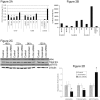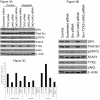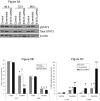Sustained Src inhibition results in signal transducer and activator of transcription 3 (STAT3) activation and cancer cell survival via altered Janus-activated kinase-STAT3 binding
- PMID: 19223541
- PMCID: PMC2929826
- DOI: 10.1158/0008-5472.CAN-08-2944
Sustained Src inhibition results in signal transducer and activator of transcription 3 (STAT3) activation and cancer cell survival via altered Janus-activated kinase-STAT3 binding
Abstract
Locoregional and distant recurrence remains common and usually fatal for patients with advanced head and neck squamous cell carcinoma (HNSCC). One promising molecular target in HNSCC is the Src family kinases (SFK). SFKs can affect cellular proliferation and survival by activating the signal transducer and activator of transcription (STAT) family of transcription factors, especially STAT3. Surprisingly, sustained SFK inhibition resulted in only transient inhibition of STAT3. We investigated the mechanism underlying STAT3 activation and its biological importance. Specific c-Src knockdown with small interfering RNA (siRNA) resulted in STAT3 activation showing specificity, which was inhibited by Janus-activated kinase (JAK; TYK2 and JAK2) depletion with siRNA. Sustained SFK inhibition also resulted in recovered JAK-STAT3 binding and JAK kinase activity after an initial reduction, although JAK phosphorylation paradoxically decreased. To determine the biological significance of STAT3 activation, we combined specific STAT3 depletion with a pharmacologic SFK inhibitor and observed increased cell cycle arrest and apoptosis. Likewise, the addition of STAT3- or JAK-specific siRNA to c-Src-depleted cells enhanced cytotoxicity relative to cells incubated with c-Src siRNA alone. These results show that reactivation of STAT3 after sustained, specific c-Src inhibition is mediated through altered JAK-STAT3 binding and JAK kinase activity and that this compensatory pathway allows for cancer cell survival and proliferation despite durable c-Src inhibition. To our knowledge, this novel feedback pathway has never been described previously. Given that pharmacologic SFK inhibitors are currently being evaluated in clinical trials, these results have potential clinical implications for cancer therapy.
Figures






Similar articles
-
Abrogation of signal transducer and activator of transcription 3 reactivation after Src kinase inhibition results in synergistic antitumor effects.Clin Cancer Res. 2007 Jul 15;13(14):4233-44. doi: 10.1158/1078-0432.CCR-06-2981. Clin Cancer Res. 2007. PMID: 17634553
-
Dual inhibition of Janus and Src family kinases by novel indirubin derivative blocks constitutively-activated Stat3 signaling associated with apoptosis of human pancreatic cancer cells.Mol Oncol. 2013 Jun;7(3):369-78. doi: 10.1016/j.molonc.2012.10.013. Epub 2012 Nov 16. Mol Oncol. 2013. PMID: 23206899 Free PMC article.
-
STAT5A-mediated SOCS2 expression regulates Jak2 and STAT3 activity following c-Src inhibition in head and neck squamous carcinoma.Clin Cancer Res. 2012 Jan 1;18(1):127-39. doi: 10.1158/1078-0432.CCR-11-1889. Epub 2011 Nov 16. Clin Cancer Res. 2012. PMID: 22090359 Free PMC article.
-
Defining the role of the JAK-STAT pathway in head and neck and thoracic malignancies: implications for future therapeutic approaches.Drug Resist Updat. 2010 Jun;13(3):67-78. doi: 10.1016/j.drup.2010.04.001. Epub 2010 May 14. Drug Resist Updat. 2010. PMID: 20471303 Review.
-
The STAT3 pathway as a therapeutic target in head and neck cancer: Barriers and innovations.Oral Oncol. 2016 May;56:84-92. doi: 10.1016/j.oraloncology.2015.11.022. Epub 2015 Dec 28. Oral Oncol. 2016. PMID: 26733183 Free PMC article. Review.
Cited by
-
[Advances of the correlation between JAK-STAT3 signaling pathway and the biological behavior of non-small cell lung cancer].Zhongguo Fei Ai Za Zhi. 2010 Feb;13(2):160-4. doi: 10.3779/j.issn.1009-3419.2010.02.16. Zhongguo Fei Ai Za Zhi. 2010. PMID: 20673511 Free PMC article. Review. Chinese. No abstract available.
-
Src kinases as therapeutic targets for cancer.Nat Rev Clin Oncol. 2009 Oct;6(10):587-95. doi: 10.1038/nrclinonc.2009.129. Nat Rev Clin Oncol. 2009. PMID: 19787002 Review.
-
Regulation of SRC family kinases in human cancers.J Signal Transduct. 2011;2011:865819. doi: 10.1155/2011/865819. Epub 2011 Apr 4. J Signal Transduct. 2011. PMID: 21776389 Free PMC article.
-
Investigational multitargeted kinase inhibitors in development for head and neck neoplasms.Expert Opin Investig Drugs. 2019 Apr;28(4):351-363. doi: 10.1080/13543784.2019.1581172. Epub 2019 Feb 26. Expert Opin Investig Drugs. 2019. PMID: 30753792 Free PMC article. Review.
-
Mechanisms underlying the cytotoxicity of a novel quinazolinedione-based redox modulator, QD232, in pancreatic cancer cells.Br J Pharmacol. 2015 Jan;172(1):50-63. doi: 10.1111/bph.12855. Br J Pharmacol. 2015. PMID: 25047070 Free PMC article.
References
-
- Jemal A, Siegel R, Ward E, Murray T, Xu J, Thun MJ. Cancer statistics, 2007. CA Cancer J Clin. 2007;57:43–66. - PubMed
-
- Johnson FM, Gallick GE. SRC family nonreceptor tyrosine kinases as molecular targets for cancer therapy. Anticancer Agents Med Chem. 2007;7:651–9. - PubMed
-
- Johnson FM, Saigal B, Talpaz M, Donato NJ. Dasatinib (BMS-354825) tyrosine kinase inhibitor suppresses invasion and induces cell cycle arrest and apoptosis of head and neck squamous cell carcinoma and non-small cell lung cancer cells. Clin Cancer Res. 2005;11:6924–32. - PubMed
-
- van Oijen MG, Rijksen G, ten Broek FW, Slootweg PJ. Overexpression of c-Src in areas of hyperproliferation in head and neck cancer, premalignant lesions and benign mucosal disorders. J Oral Pathol Med. 1998;27:147–52. - PubMed
Publication types
MeSH terms
Substances
Grants and funding
LinkOut - more resources
Full Text Sources
Other Literature Sources
Medical
Miscellaneous

